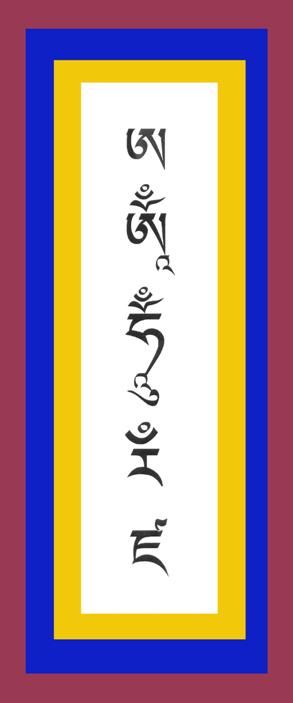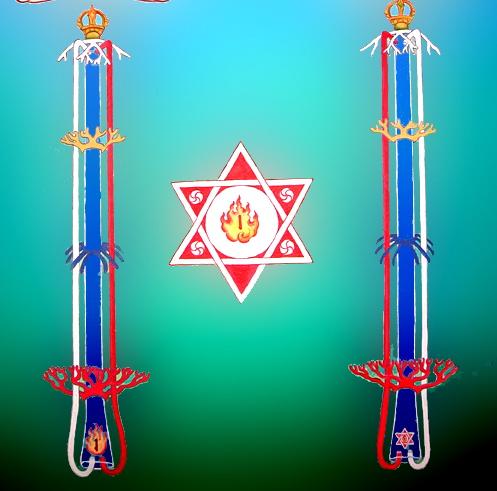

The five inner Tsa Lung Exercises
Open the Chakras
Inner refuge
Tsa (Channel)
RANG LÜ GYAL WE KYIL KHOR Ü
YÖN TEN MA LÜ JUNG WE NE
TSA SUM KHOR LO NGA YI LONG
TONG PE KU LA KYAP SU CHI
First refuge: Body
The center of the victorious mandala, one's own body,
The source of all positive qualities without exception,
Is the expanse within the three channels and the five chakras.
I take refuge in this body of emptiness. (30 sec)
Lung (Wind)
DUK NGEL PUNG PÖ TREN TSOK KÜN
YE SHE LUNG GI RAP SEL TE
MA CHÖ KA DAK NAM KHE LONG
Ö KYI KU LA KYAP SU CHI
Second refuge: Speech
All the gathered clouds of suffering and misery
Are completely cleared by the wisdom wind,
Revealing the unelaborated, primordially pure expanse of the sky.
I take refuge in this body of light. (30 sec)
Tigle (Sphere of light)
YE SHE Ö NGE GUR KHANG NE
NYI ME TIG LE Ö ZER TRÖ
MA RIK MÜN PE DRA WA SANG
DE CHEN KU LA KYAP SU CHI
Third refuge: Mind
From the pavilion of the five wisdom lights,
Rays of non-dual spheres of light emanate,
Clearing the webs of the darkness of ignorance.
I take refuge in this body of great bliss. (30 sec)
The exercises described aim to open the individual Chakras. Why is this so important now?
This can best be explained by means of a traditional image that sees the central channel as a tree, the Chakras as branches, and the pranic energy as blossoms. The qualities that belong to the individual chakras form in this concept the fruits that ripen when these qualities develop in consciousness. When the Chakras are closed, the qualities cannot fully show. Although the individual still feels compassion, this is a fairly limited experience. But once the Chakras have opened, compassion will be of course a natural reaction that involves all beings, and the basic compassion that the Buddhas feel is much more similar.
The exercises on the channels and «winds» of the Prana, which they pull through, ensure that Chakras and channels are not blocked. You have to imagine it as if you were thawing frozen water in a pipe. You can shake it, heat it or blow it through to free the tube.
The physical movement is roughly equivalent to shaking. Holding the breath and directing the Prana with the mind to the appropriate place equals heating, that is, the supply of energy. Breathing out is like blowing through.
It ensures that disabilities disappear completely from the system. The result is a sense of openness and freedom.
As I have already explained, the use of imagination serves to deepen the experience. In this way we open up the energetic level of the exercise that leads to the change of consciousness. Then we discover the Buddha of Compassion in the Heart, the Buddha of Bliss in Crown Chakra, the Buddha of Bliss in the Throat Chakra, the Buddha of Wisdom in the Navel Chakra, and the Buddha of Generosity in the Secret Chakra.
Sometimes people have special experiences when a chakra opens. Since people in the West have learned to perceive energy blockages in the body as emotions rather than as physical or energetic obstacles, solving such obstacles often involves an emotional catharsis. In Tibetan culture, on the other hand, there are more unpredictable experiences on the energetic or physical level:
The practitioner starts to shiver, squirm, or twitch. He gets dizzy, maybe he sweats too. Other people suddenly have inner images in mind when they focus on a chakra. These may be associated with the special blockages - negative memories, traumas, and more like that - that have hindered the flow of energy in this chakra. But positive images may also arise that are related to the chakra itself: spiritual symbols, deities, Buddhas, goddesses and so on.
The five inner Tsa Lung Exercises
As with all spiritual exercises, the mastery of the outer form is the simplest part. It is even more difficult if we are to learn how to generate the inner experience. If we perform such exercises while our minds are wandering diligently, we probably will not get any resounding results. Therefore, it is important that we try to understand what purpose each part of the practice serves, which goal is strived, what method is used. Stay in the practice as much as possible during the entire exercise. The next series of exercises follows the same goal as the first one. Although this involves the so-called «inner» level, physical exercises are needed here too, albeit to a lesser extent than in the five outer Tsa Lung Exercises. We work with the same pranic forms and Chakras as before.
The Upward Prana
This exercise opens the top of the Central Channel, as well as the Throat and Crown Chakra.
Breathe in. Close your mouth, close your nose, and exhale gently as if you were sitting on the plane trying to relieve pressure. Be careful not to hurt your ears. In this case, do not open your ears, but use the internal pressure to direct your attention to the Crown Chakra. Feel as intense as possible how the center feels at the apex. With the help of your imagination you concentrate the pressure in the Central Channel and notice how this opens the chakra.
If you do not feel anything, just let your attention rest in the Crown Chakra and create there a slight pressure with your breath held.
On the other hand, if you have a sensation, immerse yourself in it and stay present. The breath becomes completely natural. Focus your attention on the Crown Chakra while leaving the mind completely open and free.
Exhale and guide the Prana again down the chakra. (2 min)
Do this exercise whenever you feel like it, but above all when you feel dejected, depressed or lethargic. Or if you think you are not strong enough for the task ahead of you; if you lack clarity and alertness; and if you are confused or distracted.
The Prana of the Life Force
The Prana of the Life Force sits in the Heart Chakra. Feel your heartbeat. Put your hand over your chest if necessary. Take a deep breath in and out. Relax; then inhale. Imagine breathing light and positive energy from all directions into your heart as you inhale, flow into your Heart Chakra, and strengthen the Prana of life force.
Stay relaxed and hold your breath. Focus it in the Heart Chakra to gather the energy there. Focus on chest space, stretching in the muscles and on the surface of the skin to keep your attention in the chest. Then exhale very slowly and relax completely. (2 min)
Repeat the exercise, focusing your attention on the Heart Chakra in the Central Channel. When you have finished the exercise, stay in that experience for as long as it feels fresh. (3 min)
Do these exercises in situations as described above. Also, whenever you feel that something is wasting your life energy, you are deprived of vitality, leaving you frustrated and unhappy. This exercise is good for centering the consciousness.
The Fire-Like Prana
The Fire-Like Prana is located in the navel center. Imagine the abdominal cavity as a huge ocean. The spine is the rock on the beach. The waves splash over the beach and wash around the rocks before they go back.
Breathe in, hold your breath as you pull the abdominal wall toward your spine, and then slowly release it as you exhale slowly. Rest in pure awareness. (2 min)
Repeat the exercise. (3 min)
This practice is especially good when you are exhausted and giddy. Watch for a feeling of increasing warmth in the abdominal area. Then use your imagination to let the Fire Prana circulate throughout your body.
The All-Pervading Prana
The All-Pervading Prana is distributed throughout the body. Lie on your back or take the meditation posture described above. As you exhale, gather your body as much as possible so that you take up a minimum of space. Tighten all muscles. As you inhale, slowly open your fingers, relax your back, arms, legs, and so on. Stretch, relax. You now take up as much space as possible. As you stretch your limbs, you feel the All-Pervading Prana catching all of your body parts from the middle of your body to the tips of your fingers and toes.
Exhale and relax in pure awareness. The Prana pervades your whole body and the space around you. (3 min)
This practice is especially helpful in the morning after awakening. But of course you can do it whenever you want.
The Downward Prana
In this exercise, you focus on the Secret Chakra behind the genitals. Tighten the pelvic floor by contracting the muscles of the perineum and anus. Stay that way for a few minutes, then let go. (2 min)
Repeat the exercise. If you want, you can also hold your breath while holding the tension and releasing it again. (3 min)
Does this with breath hold several times. At the last release you exhale and direct the Prana down out of the body. Meld with the relaxation that sets in with letting go. This relaxation impulse makes the exercise especially advisable when you are anxious or have lost your centeredness. (3 min)
 The five warrior seed syllables: AH, OM, HUNG, RAM, TSA
The five warrior seed syllables: AH, OM, HUNG, RAM, TSA
 The central channel and the two side channels from the front and the back (white channel ⇒ left; red ⇒ right
The central channel and the two side channels from the front and the back (white channel ⇒ left; red ⇒ right
Dedication
(ngo mön)
GO SUM DAK PE GE WA GANG GYI PA
KHAM SUM SEM CHEN NAM KYI DÖN DU NGO
DUK SUM SAK PE LE DRIP KÜN JANG NE
KU SUM DZOK PE SANG GYE NYUR TOP SHOK
All pure virtue done through the Three Doors,
I dedicate to the welfare of all sentient beings of the Three Realms.
Having purified all afflictions and obscurations of the Three Poisons,
May we swiftly achieve the complete Buddhahood of the Three Bodies.
Dedication prayer
(ngo wa)
KYAP NE SUM LA DING CHEN TOP PAR SHOK
GO SUM NYAM TOK YE SHE GYE PAR SHOK
DUK SUM DAK NE KU SUM TOP PAR SHOK
RANG GYÜ DRÖL NE ZHEN LA PEN PAR SHOK
May I gain great confidence in the Three Refuges.
May my experiences and my realization of wisdom of the Three Doors increase.
By purifying the Three Poisons, may I receive the Three Bodies.
By liberating myself in my own being, may I benefit others.
Explanation of the terms in the dedication:
Three Doors — Body, Speech, Mind
Three Realms — desirable, shape, shapeless
Three Poisons — Aversion, Desire, Ignorance
Three Bodies (or dimensions) —
bön ku or Dharmakaya;
dzok ku, long ku, or Sambhogakaya; and
trül ku or Nirmanakaya
